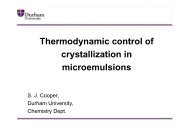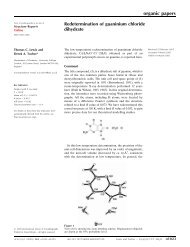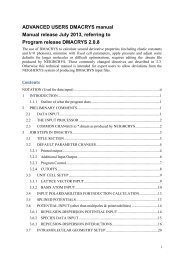An Introduction to the Theory of Crystalline Elemental Solids and ...
An Introduction to the Theory of Crystalline Elemental Solids and ...
An Introduction to the Theory of Crystalline Elemental Solids and ...
You also want an ePaper? Increase the reach of your titles
YUMPU automatically turns print PDFs into web optimized ePapers that Google loves.
26<br />
a much richer variety <strong>of</strong> reconstructions than metal surfaces do, which is certainly <strong>the</strong><br />
case. Fortunately, however, much <strong>of</strong> <strong>the</strong> qualitative insight in<strong>to</strong> semiconduc<strong>to</strong>r surfaces<br />
has been condensed in<strong>to</strong> a series <strong>of</strong> general principles, first laid down by Duke [105, 106]<br />
<strong>and</strong> discussed at length in several o<strong>the</strong>r places [104, 107]. A discussion <strong>of</strong> <strong>the</strong> relevant<br />
principles [108] along with a few examples is sufficient <strong>to</strong> provide a flavor for how some<br />
<strong>of</strong> <strong>the</strong> most-common elemental semiconduc<strong>to</strong>r surfaces behave.<br />
The first principle which we discuss here is <strong>of</strong>ten described as <strong>the</strong> basic or guiding<br />
principle <strong>of</strong> semiconduc<strong>to</strong>r surfaces <strong>and</strong> it states that “<strong>the</strong> surface structure observed will<br />
be <strong>the</strong> lowest free energy structure kinetically accessible under <strong>the</strong> preparation conditions”.<br />
This, ra<strong>the</strong>r obvious statement, is true <strong>of</strong> any surface. However, it is especially pertinent<br />
<strong>to</strong> semiconduc<strong>to</strong>rs since which surface is observed is known <strong>to</strong> depend sensitively on<br />
cleavage, annealing, <strong>and</strong> growth conditions.<br />
Stemming from <strong>the</strong> guiding principle are a series <strong>of</strong> o<strong>the</strong>r principles. Of relevance <strong>to</strong> <strong>the</strong><br />
present discussion on elemental semiconduc<strong>to</strong>rs is one that states that “...<strong>the</strong> surface<br />
a<strong>to</strong>mic geometry is determined primarily by a rehybridization-induced lowering <strong>of</strong> <strong>the</strong><br />
surface state b<strong>and</strong>s associated with surface bonds or (filled) anion dangling bond states”.<br />
Put ano<strong>the</strong>r way this principle simply implies that a surface tends <strong>to</strong> minimize <strong>the</strong> number<br />
<strong>of</strong> dangling bonds by formation <strong>of</strong> new bonds <strong>and</strong>/or rehybridization. The concept <strong>of</strong> <strong>the</strong><br />
“dangling” bond is absolutely key <strong>to</strong> underst<strong>and</strong>ing semiconduc<strong>to</strong>r surface reconstructions.<br />
In an elemental semiconduc<strong>to</strong>r, covalent bonds between neighboring a<strong>to</strong>ms contain<br />
two spin paired electrons in, for example, an sp 3 hybrid orbital. When a surface is created<br />
at least one such bond per surface a<strong>to</strong>m is cut, leaving some sp 3 hybrid orbitals <strong>to</strong> stick<br />
out <strong>of</strong> <strong>the</strong> surface. These orbitals are called dangling bonds <strong>and</strong> <strong>the</strong>y contain less than<br />
two spin paired electrons. Dangling bonds are unstable <strong>and</strong> reactive <strong>and</strong> so <strong>the</strong> above<br />
principle is simply stating that real surfaces will relax or reconstruct <strong>to</strong> reduce <strong>the</strong> number<br />
<strong>of</strong> dangling bonds <strong>the</strong>y possess <strong>and</strong>, in so doing, minimize <strong>the</strong> <strong>to</strong>tal energy <strong>of</strong> <strong>the</strong> system.<br />
Dangling bond states are surface-localized orbitals that reside at an energy between<br />
<strong>the</strong> valence <strong>and</strong> conduction b<strong>and</strong>s. Thus <strong>the</strong>se are surface states. Naturally, dangling<br />
bonds on neighboring a<strong>to</strong>ms interact <strong>and</strong> so <strong>the</strong> dangling bond levels get broadened in<strong>to</strong><br />
b<strong>and</strong>s. As an example we show in Fig. 11 <strong>the</strong> computed surface b<strong>and</strong> structure <strong>of</strong> <strong>the</strong><br />
unreconstructed (100), (110), <strong>and</strong> (111) surfaces <strong>of</strong> Si. These are <strong>the</strong> pro<strong>to</strong>type dangling<br />
bond systems; with <strong>the</strong> dangling bonds clearly seen in <strong>the</strong> fundamental gap in each system.<br />
The o<strong>the</strong>r principle relevant <strong>to</strong> elemental semiconduc<strong>to</strong>rs is one that states that “...surfaces<br />
can lower <strong>the</strong>ir energies by a<strong>to</strong>mic relaxations leading <strong>to</strong> semiconducting (as opposed<br />
<strong>to</strong> metallic) surface state eigenvalue spectra”. Basically this principle implies that a<br />
semiconduc<strong>to</strong>r surface tends <strong>to</strong> be insulating or semiconducting but not metallic. In<br />
general, if <strong>the</strong>re is a single dangling bond per surface a<strong>to</strong>m or when two or more dangling<br />
bond b<strong>and</strong>s overlap <strong>the</strong>n <strong>the</strong> surface is metallic. O<strong>the</strong>rwise <strong>the</strong> surface is semiconducting.<br />
All three bulk-truncated surfaces <strong>of</strong> <strong>the</strong> diamond lattice shown in Fig. 8 are metallic <strong>and</strong><br />
thus liable <strong>to</strong> reconstruct.<br />
Let’s now consider how <strong>the</strong> (001) <strong>and</strong> (111) surfaces <strong>of</strong> <strong>the</strong> diamond lattice behave.<br />
First, <strong>the</strong> (001) surface. This surface, in particular <strong>the</strong> (001) surface <strong>of</strong> Si, has been<br />
examined in detail at least as much as any o<strong>the</strong>r solid surface; <strong>of</strong>ten being described<br />
as <strong>the</strong> backbone <strong>of</strong> <strong>the</strong> semiconduc<strong>to</strong>r industry. The Si(001) surface undergoes a large<br />
number <strong>of</strong> reconstructions, notably <strong>to</strong> p(2×1), p(2×2), <strong>and</strong> c(4×2) phases. We discuss







